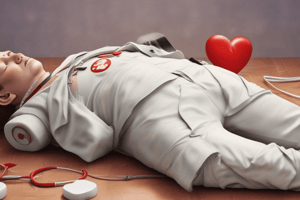Podcast
Questions and Answers
In a two-rescuer CPR scenario, what is the MOST significant advantage compared to one-rescuer CPR regarding chest compressions?
In a two-rescuer CPR scenario, what is the MOST significant advantage compared to one-rescuer CPR regarding chest compressions?
- The ratio of compressions to breaths can be reduced to simplify the process.
- Rescuers can rotate compressor roles more frequently, preventing fatigue and maintaining compression quality. (correct)
- The depth of compressions can be shallower, minimizing the risk of injury.
- There is less emphasis on providing breaths, allowing for uninterrupted compressions.
When assessing a patient, what is the FIRST step a healthcare provider should typically perform?
When assessing a patient, what is the FIRST step a healthcare provider should typically perform?
- Taking the patient's blood pressure
- Starting chest compressions
- Checking for responsiveness (correct)
- Administering oxygen
What is the PRIMARY criterion used to determine if CPR should be initiated on a patient?
What is the PRIMARY criterion used to determine if CPR should be initiated on a patient?
- Patient's skin color being pale
- Visible signs of bleeding
- Lack of pulse and breathing (correct)
- Presence of dilated pupils
During AED use, what is a critical safety rule to follow to ensure effective defibrillation and prevent harm?
During AED use, what is a critical safety rule to follow to ensure effective defibrillation and prevent harm?
When using an AED on an infant, what modification to pad placement is generally recommended if standard-sized pads are too large?
When using an AED on an infant, what modification to pad placement is generally recommended if standard-sized pads are too large?
When providing care to a choking adult who becomes unresponsive, what is the IMMEDIATE next step after calling for help?
When providing care to a choking adult who becomes unresponsive, what is the IMMEDIATE next step after calling for help?
During rescue breathing, what is the correct protocol for delivering breaths to an infant?
During rescue breathing, what is the correct protocol for delivering breaths to an infant?
After delivering a shock with an AED and completing the recommended two minutes of CPR, what is the MOST important next step?
After delivering a shock with an AED and completing the recommended two minutes of CPR, what is the MOST important next step?
When using a bag valve mask (BVM), what is the primary goal in terms of ventilation?
When using a bag valve mask (BVM), what is the primary goal in terms of ventilation?
Why is it important to re-check for a pulse periodically during rescue breathing?
Why is it important to re-check for a pulse periodically during rescue breathing?
Flashcards
CPR basics
CPR basics
CPR involves specific rates, ratios, and compression depths tailored for adults, children, and infants.
Patient assessment order
Patient assessment order
Involves assessing the patient's condition to determine the appropriate intervention.
CPR criteria
CPR criteria
CPR is initiated if the patient lacks a pulse or isn't breathing.
AED function
AED function
Signup and view all the flashcards
Choking care
Choking care
Signup and view all the flashcards
When to rescue breathe?
When to rescue breathe?
Signup and view all the flashcards
Re-checking pulse
Re-checking pulse
Signup and view all the flashcards
Bag valve mask
Bag valve mask
Signup and view all the flashcards
Study Notes
- Study guide for CPR written exam
CPR Fundamentals
- Need to know rates, ratios, and depths of compressions for adults, children, and infants.
- Understand the differences between one- and two-rescuer CPR.
Patient Assessment
- Understand the correct order for patient assessment.
CPR Criteria
- Establish the criteria for performing CPR including checking for pulse and breathing.
AED Usage
- Know when to use an AED and what it does.
- Learn the rules and protocols for AED use, including considerations for water, pad placement, and differences between adult and infant pads.
- Learn the order of steps for usage.
Choking
- Acquire the proper care techniques for conscious and unconscious choking patients of all ages (adult, child, infant).
Rescue Breathing
- Understand when to perform rescue breathing.
- Know the protocol for rescue breathing for all ages (adult, child, infant).
- Understand when to re-check for a pulse during rescue breathing.
Bag Valve Mask
- Learn the recommended use of the bag valve mask.
Studying That Suits You
Use AI to generate personalized quizzes and flashcards to suit your learning preferences.




